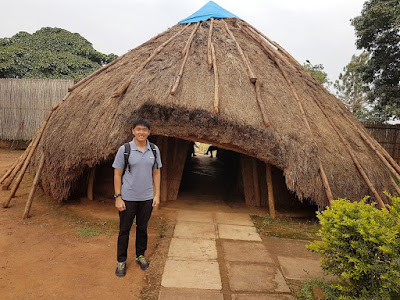1-1 Yoyogikamizonocho, Shibuya, Tokyo, Japan
Daily: 5.00am - 6.00pm
Meiji Jingu is a Shinto shrine dedicated to the deified spritis of Emperor Meiji and his wife, Empress Shoken. Completed in 1921, it was built to commemorate the pivotal role of the emperor in the 1868 Meiji Restoration that saw Japan rapidly industrialising and adopting Western ideas and production methods to progress further.
The expansive Meiji Jingu premise is located between Yoyogi and Harajuku railway stations. My BFF and I actually walked all the way there from
Hotel Listel Shinjuku, catching lots of fresh air along the way.
 |
| That's actually a sign indicating that the area I'm standing at is an evacuation site. |
 |
It's one of the two largest wooden torii (Shinto shrine gate) in Japan.
The other one is located at the other end. |
I really enjoyed the serenity of the forested area, which is about 70 hectares big.
 |
| Not just no smoking, but also no eating and drinking while walking! |
 |
| The forest is mainly composed of evergreen broadleaf trees, such as chinquapin, oak and camphor. |
There's a modern assembly hall, which is probably used only on special occasions.
The water ablution pavilion that's found at the entrance of a Shinto shrine is called temizu-ya or chozu-ya (手水舎). It appears that both kunyomi (Japanese reading) and onyomi (Chinese reading) are widely acceptable in this case.
 |
| Wash your left hand, right hand, mouth and finally the handle of the ladle. |
Before exploring the grounds, we checked out the gift shop first.
 |
The estimated cost of the construction was approximately US$26 million today,
about a quarter of the actual predicted cost due to the donated materials and labour. |
 |
| I've bought some amulets as gifts before, but I've never actually bought one for myself. |
 |
| I love collecting stamps. Do you? |
It's truly unfortunate that the original shrine building was destroyed during the Tokyo air raids of Word War II. The present form was funded through a public fund raising effort and completed in 1958.
 |
| The two main materials used for the construction of the shrine are Japanese cypress and copper. |
 |
As there seemed to be a special ceremony going on inside the main building,
we only took a look from outside and didn't take any photos of the interior. |
There's a couple of camphor trees that were planted at the time of the enshrinement of Meiji Jingu in 1920. Considered to be sacred, they're hoped to bring happiness to visitors through their divine powers.
As we were walking towards the southern wooden
torii, we saw an impressive display of not only barrels of
sake (Japanese rice wine) wrapped in straw, but also those of Burgundy wine from France consecrated as part of the adoption of 'Japanese Spirit and Western Knowledge' ideology during the Meiji era.
 |
| "Ladies and gentlemen, which is your favourite design?" |
We also chanced upon two restaurants and a souvenir shop.
 |
| Freshly made dango (Japanese skewered rice dumplings), anyone? |
Unfortunately, the skewers were still being prepared when we walked past the stall, so we didn't get a chance to try.
 |
| We left the premise just before 10.00am and saw more people entering. |
The premise doesn't contain the grave of the emperor. It's actually located at Fushimi-Momoyama in the southern part of Kyoto.











































Comments
Post a Comment